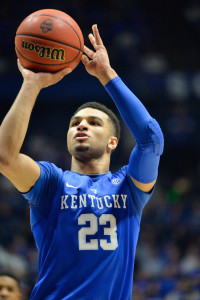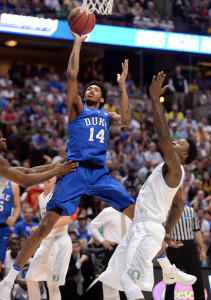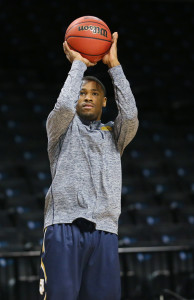PROJECTED DRAFT RANGE: Chad Ford of ESPN.com has Murray as the third best prospect. The 19-year-old could go as high as No. 3 to the Celtics and Ford doesn’t envision him falling past the Pelicans at No.6. That’s the spot where Jonathan Givony of Draft Express has Murray in his latest mock draft and Givony ranks Murray as the sixth best prospect.
RISE/FALL: Barring an injury to Ben Simmons or Brandon Ingram, Murray won’t be selected in the top-2. More likely, Murray comes off the board at No. 3, No. 5 or No.6.
FIT: The Celtics have a loaded backcourt. Yet, none of their incumbent players have the ceiling that Murray has, so he remains a possibility since Danny Ainge will be using the No. 3 overall pick with the franchise’s long-term future in mind. Trading that pick remains a possibility as well and the Sixers are a logical trade partner should they offer up Jahlil Okafor. Murray would be a nice fit for the Sixers, as one anonymous executive told Keith Pompey of the Philadelphia Inquirer earlier this week.
The Wolves have a talented young core and Murray’s shooting would impeccably complement Andrew Wiggins‘ and Karl-Anthony Towns‘ interior games. Minnesota can’t consistently play Wiggins, Zach LaVine and Ricky Rubio on the perimeter if it wants to improve in the win column because the trio simply doesn’t possess the long-range shooting necessary to evoke fear in opposing defenses. Smart coaches will let their players sag off these guys and allow them to fire away from downtown. Adding Murray to the equation changes the dynamics. Having a competent shooter on the floor would allow Wiggins to have more room to drive to the basket, a skill he excelled at during his sophomore season in the NBA, even with the team’s poor spacing.
If the team drafts Murray, it can consider moving on from Rubio with the hopes that either Murray or LaVine can develop into a full-time point guard. Minnesota could simply keep Rubio and grant Murray the time to develop into that role. Even if Murray doesn’t become the point guard he believes he can be, he would make a great partner in the backcourt to Rubio or LaVine because of his tremendous shooting ability and I speculate that he doesn’t fall past the Wolves at No. 5.
The Pelicans probably hope he falls to No.6, as they could use Murray the most out of the aforementioned teams. Eric Gordon is a free agent this summer and they may bring him back if the market softens on him, but the Gordon-Jrue Holiday–Tyreke Evans combination never really took off as a result of injuries and overlapping skill sets. Adding Murray would address a problematic area for New Orleans: the back-up point guard spot. Holiday has seen his fair share of injuries since arriving in Louisiana. When he’s unable to play, the offense sputters. Murray would give the Pelicans a nice option at the point should Holiday miss more time in the future or if the team decides to move on from Holiday all together.
FINAL TAKE: Murray may be the best shooter in the draft and in a league where the 3-point shot is being stressed more and more, he should provide immediate value to whichever team drafts him. His floor seems to be a Jamal Crawford-type player who is best suited for a second unit. However, he has the potential to be a star. Whether or not he can play the point guard position full-time and improve on the defensive end will determine his status in the league.
(For Part One of our Jamal Murray Prospect Profile, click here)


